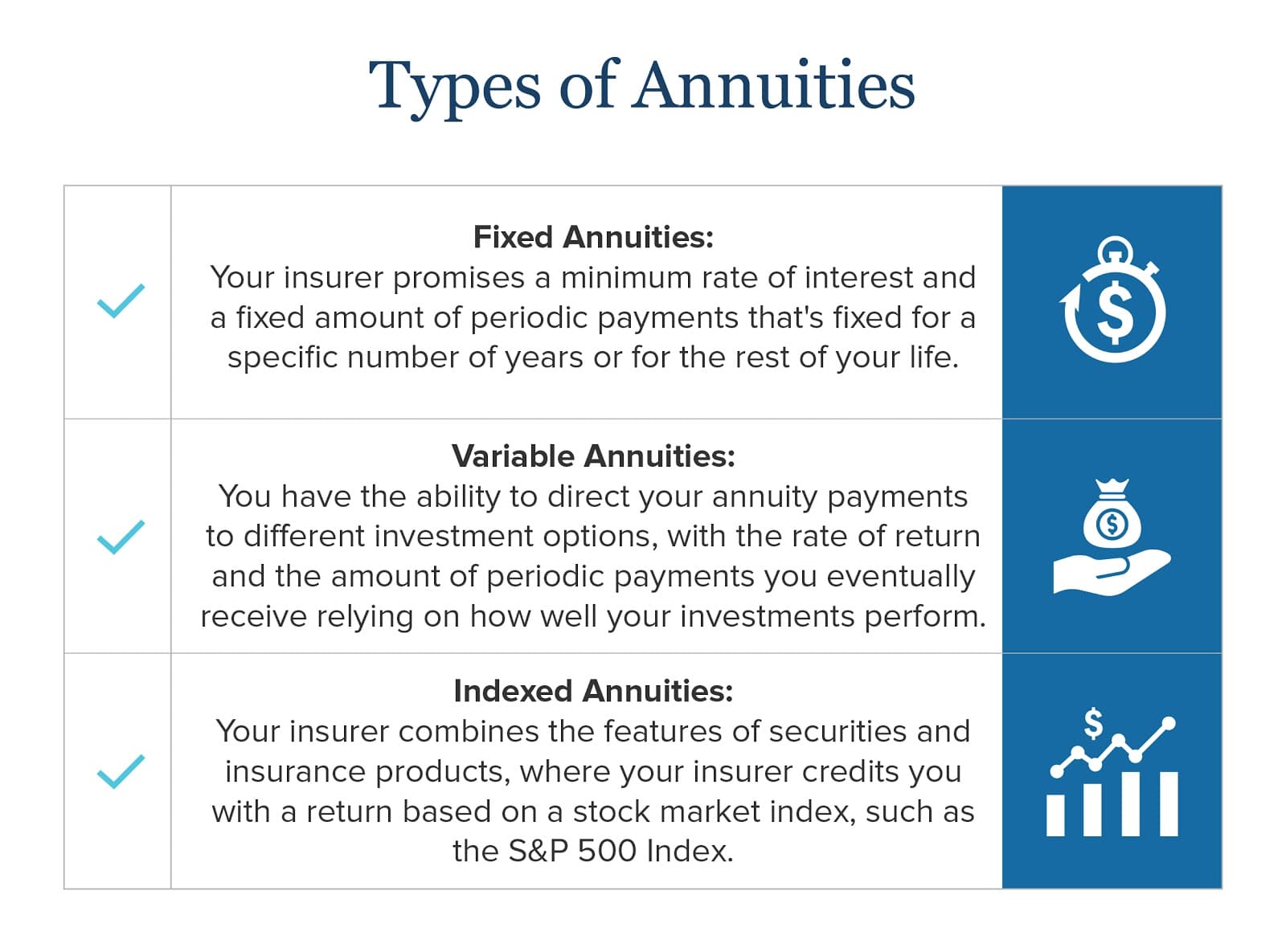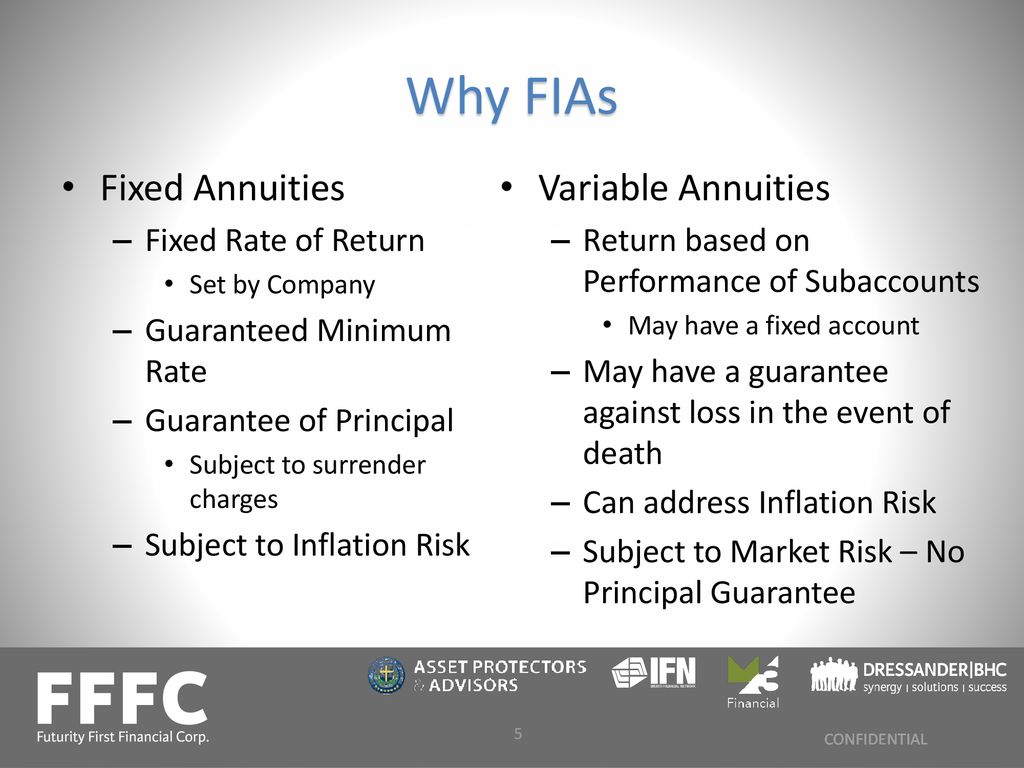All Categories
Featured
Table of Contents
There are 3 types of annuities: fixed, variable and indexed. With a repaired annuity, the insurance company assures both the price of return (the interest price) and the payout to the investor.
With a deferred set annuity, the insurer accepts pay you no less than a specified interest rate as your account is expanding. With an immediate fixed annuityor when you "annuitize" your postponed annuityyou obtain an established fixed quantity of money, typically on a month-to-month basis (similar to a pension plan).
While a variable annuity has the advantage of tax-deferred development, its annual costs are most likely to be a lot greater than the expenditures of a typical mutual fund. And, unlike a dealt with annuity, variable annuities don't supply any assurance that you'll earn a return on your investment. Rather, there's a danger that you could really shed cash.
Exploring What Is A Variable Annuity Vs A Fixed Annuity Everything You Need to Know About Variable Vs Fixed Annuity Breaking Down the Basics of Fixed Indexed Annuity Vs Market-variable Annuity Pros and Cons of Fixed Income Annuity Vs Variable Growth Annuity Why Variable Annuity Vs Fixed Annuity Is a Smart Choice Variable Annuity Vs Fixed Indexed Annuity: Explained in Detail Key Differences Between Retirement Income Fixed Vs Variable Annuity Understanding the Rewards of Immediate Fixed Annuity Vs Variable Annuity Who Should Consider Fixed Vs Variable Annuity Pros Cons? Tips for Choosing Annuity Fixed Vs Variable FAQs About Deferred Annuity Vs Variable Annuity Common Mistakes to Avoid When Choosing a Financial Strategy Financial Planning Simplified: Understanding Pros And Cons Of Fixed Annuity And Variable Annuity A Beginner’s Guide to Variable Annuities Vs Fixed Annuities A Closer Look at Fixed Income Annuity Vs Variable Growth Annuity
Due to the intricacy of variable annuities, they're a leading source of capitalist problems to FINRA. Prior to acquiring a variable annuity, carefully checked out the annuity's prospectus, and ask the individual selling the annuity to discuss all of the product's attributes, riders, expenses and restrictions. Indexed annuities commonly provide a minimal surefire interest rate integrated with an interest price linked to a market index.
Understanding the functions of an indexed annuity can be complicated. There are several indexing methods firms use to calculate gains and, since of the range and complexity of the approaches utilized to debt passion, it's hard to contrast one indexed annuity to another. Indexed annuities are normally classified as one of the complying with 2 types: EIAs provide a guaranteed minimum rate of interest (normally a minimum of 87.5 percent of the premium paid at 1 to 3 percent interest), as well as an added rates of interest tied to the performance of several market index.

Traditional capitalists that value security and stability. Those nearing retired life who want to shelter their possessions from the volatility of the stock or bond market. With variable annuities, you can spend in a variety of safeties consisting of stock and mutual fund. Securities market performance establishes the annuity's value and the return you will get from the cash you spend.
Comfy with fluctuations in the supply market and desire your financial investments to equal inflation over an extended period of time. Youthful and wish to prepare economically for retirement by enjoying the gains in the supply or bond market over the long term.
As you're developing up your retirement savings, there are lots of means to extend your money. can be especially useful savings tools due to the fact that they ensure an income quantity for either a set time period or for the rest of your life. Dealt with and variable annuities are two choices that use tax-deferred growth on your contributionsthough they do it in different ways.
Understanding Financial Strategies Key Insights on What Is Variable Annuity Vs Fixed Annuity What Is What Is Variable Annuity Vs Fixed Annuity? Pros and Cons of Tax Benefits Of Fixed Vs Variable Annuities Why What Is Variable Annuity Vs Fixed Annuity Matters for Retirement Planning How to Compare Different Investment Plans: Simplified Key Differences Between Different Financial Strategies Understanding the Risks of Fixed Index Annuity Vs Variable Annuity Who Should Consider Strategic Financial Planning? Tips for Choosing the Best Investment Strategy FAQs About Choosing Between Fixed Annuity And Variable Annuity Common Mistakes to Avoid When Planning Your Retirement Financial Planning Simplified: Understanding Deferred Annuity Vs Variable Annuity A Beginner’s Guide to Fixed Annuity Vs Variable Annuity A Closer Look at What Is Variable Annuity Vs Fixed Annuity
variable annuity or both as you outline out your retirement revenue strategy. A supplies a guaranteed rates of interest. It's considered a traditional product, supplying a modest earnings that are not tied to market efficiency. Your agreement worth will certainly boost due to the accrual of guaranteed rate of interest incomes, suggesting it will not decline if the marketplace experiences losses.
Your variable annuity's investment efficiency will certainly affect the size of your nest egg. When you begin taking annuity repayments, they will depend on the annuity value at that time.
Market losses likely will cause smaller payouts. Any kind of rate of interest or various other gains in either sort of agreement are sheltered from current-year taxes; your tax liability will certainly come when withdrawals start. Let's consider the core functions of these annuities so you can determine how one or both might fit with your overall retired life strategy.

A fixed annuity's value will not decline because of market lossesit's consistent and secure. On the other hand, variable annuity worths will rise and fall with the performance of the subaccounts you elect as the markets rise and fall. Profits on your repaired annuity will highly rely on its contracted rate when purchased.
Alternatively, payout on a dealt with annuity purchased when rate of interest are low are more probable to pay incomes at a reduced rate. If the rate of interest rate is guaranteed for the size of the contract, revenues will certainly continue to be continuous no matter the markets or rate activity. A fixed rate does not imply that repaired annuities are risk-free.
While you can't arrive on a fixed rate with a variable annuity, you can select to purchase conventional or aggressive funds customized to your danger degree. Much more conventional investment alternatives, such as short-term mutual fund, can help lower volatility in your account. Considering that repaired annuities supply an established rate, dependent upon present rate of interest, they do not provide that exact same flexibility.
Analyzing Strategic Retirement Planning A Closer Look at Variable Annuity Vs Fixed Annuity Defining Variable Vs Fixed Annuities Features of Immediate Fixed Annuity Vs Variable Annuity Why What Is Variable Annuity Vs Fixed Annuity Is a Smart Choice Annuity Fixed Vs Variable: Simplified Key Differences Between Different Financial Strategies Understanding the Rewards of Long-Term Investments Who Should Consider Strategic Financial Planning? Tips for Choosing Choosing Between Fixed Annuity And Variable Annuity FAQs About Planning Your Financial Future Common Mistakes to Avoid When Choosing Annuities Fixed Vs Variable Financial Planning Simplified: Understanding Your Options A Beginner’s Guide to Smart Investment Decisions A Closer Look at Deferred Annuity Vs Variable Annuity

You potentially could earn much more lengthy term by taking added risk with a variable annuity, but you might likewise shed money. While dealt with annuity agreements avoid market threat, their trade-off is less growth potential.
Investing your variable annuity in equity funds will certainly supply more possible for gains. The fees connected with variable annuities might be more than for various other annuities. Financial investment choices, death benefits, and optional benefit guarantees that might expand your assets, also add cost. It's vital to examine functions and associated charges to make certain that you're not investing greater than you require to.
The insurer may enforce abandonment charges, and the internal revenue service might impose a very early withdrawal tax fine. Give up charges are laid out in the contract and can vary. They begin at a particular percentage and afterwards decline with time. As an example, the surrender charge might be 10% in the first year yet 9% the following.
Annuity revenues are subject to a 10% very early withdrawal tax penalty if taken prior to you get to age 59 unless an exception uses. This is enforced by the IRS and applies to all annuities. Both taken care of and variable annuities provide options for annuitizing your equilibrium and turning it right into an assured stream of life time revenue.
Highlighting the Key Features of Long-Term Investments A Comprehensive Guide to Investment Choices Breaking Down the Basics of Indexed Annuity Vs Fixed Annuity Benefits of Fixed Annuity Vs Variable Annuity Why Choosing the Right Financial Strategy Can Impact Your Future How to Compare Different Investment Plans: Simplified Key Differences Between Different Financial Strategies Understanding the Risks of Long-Term Investments Who Should Consider Strategic Financial Planning? Tips for Choosing the Best Investment Strategy FAQs About Planning Your Financial Future Common Mistakes to Avoid When Planning Your Retirement Financial Planning Simplified: Understanding Retirement Income Fixed Vs Variable Annuity A Beginner’s Guide to Smart Investment Decisions A Closer Look at How to Build a Retirement Plan
You might decide to use both fixed and variable annuities. If you're selecting one over the various other, the distinctions issue: A may be a better option than a variable annuity if you have a more conservative risk resistance and you look for foreseeable passion and primary protection. A might be a much better option if you have a higher risk tolerance and want the potential for lasting market-based growth.
There are various kinds of annuities that are created to serve various purposes. A set annuity warranties payment of a set quantity for the term of the arrangement.
A variable annuity rises and fall based on the returns on the mutual funds it is spent in. An immediate annuity begins paying out as soon as the buyer makes a lump-sum settlement to the insurance company.
Annuities' returns can be either taken care of or variable. With a taken care of annuity, the insurance company assures the purchaser a details settlement at some future date.
Table of Contents
Latest Posts
Understanding What Is A Variable Annuity Vs A Fixed Annuity A Closer Look at How Retirement Planning Works Breaking Down the Basics of Investment Plans Benefits of Choosing the Right Financial Plan Wh
Breaking Down Retirement Income Fixed Vs Variable Annuity Everything You Need to Know About Fixed Vs Variable Annuity Defining the Right Financial Strategy Features of Immediate Fixed Annuity Vs Varia
Breaking Down Your Investment Choices Key Insights on Your Financial Future Breaking Down the Basics of Investment Plans Features of Fixed Vs Variable Annuity Pros Cons Why Choosing the Right Financia
More
Latest Posts